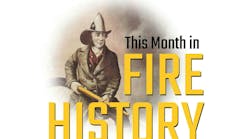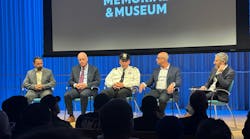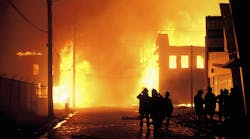Paul Hashagen describes the keeping of a promise to New York City firefighters made just after the Civil War to return a kindness, “should misfortune ever befall the Empire City.”
On the morning of Sept. 11, 2001, the nation’s attention was drawn to the live TV coverage of the unfolding terrorist attack on New York City’s World Trade Center’s “Twin Towers.” In Columbia, SC, the staff of the White Knoll Middle School was riveted to the TV coverage of the original plane crash. Watching live, they and a good portion of America watched a second plane strike the south tower. The staff and the country became numb. Coverage continued as the unthinkable happened – the south tower collapsed, followed by the collapse of the north tower.
The school’s staff was horrified. The principal, Dr. Nancy Turner, was especially haunted by the shots of the smoldering, crushed wreckage of the New York City fire trucks. Turner and her staff were concerned and upset. How should the faculty and students react to the tragedy?
Turner did not want to just raise money for some large charity, she wanted the WKMS (White Knoll Middle School) efforts to be more personal. She called for a full staff meeting. All the teachers, office staff and buildings personnel gathered and waited for their principal’s address. Turner’s idea was just beginning to jell in her mind. The vision of the destroyed fire apparatus became the focus of her plan.
The staff sat quietly as Turner explained her idea – buy a new fire truck to replace one of those that was lost. It made perfect sense to her, but what would the staff think? They were sitting quietly looking at her. A moment of doubt crossed Turner’s mind, so she just asked the staff to consider her idea and get back to her.
Suddenly, a hand shot up in the audience. A teacher stated that she thought it was a great idea and made a motion to enact the principal’s plan. The motion was carried unanimously. Turner was gratified by the vote of confidence as the meeting adjourned.
With a plan now in place certain questions came up: Just how much does a fire truck cost? A call was made to the Columbia Fire Department asking for information on fire truck prices. Eventually, Turner found herself talking to Chief Jack Jansen of the Columbia Fire Department. Her idea was explained and her questions were asked. The chief thought the idea was great and advised the educator that fire truck prices ran from $250,000 for a pumper to $400,000 to $500,000 for ladder trucks. A brief explanation of rigs and their various roles on the fireground was included.
Jansen then told Turner an amazing story that he and Fire Marshal John Reich had been researching for some time. It was a story that only became more poignant with the losses faced by the FDNY.
Late in the Civil War, Union General William Tecumseh Sherman drove his troops through Columbia, the capital of South Carolina. The city was left in smoldering ruins. Block after block was devoured by the flames. One historian, Walder Edgar, described the scene in his book, South Carolina: A History: “When dawn broke, Columbia could see nothing but a forest of broken chimneys and piles of rubble. The business district and portions of the best residential areas were gone.” Thirty-six blocks were consumed. One-third of the city was lost. Only one fire station remained standing, the Palmetto Fire Engine Company on Blanding Street. The city had suffered greatly and was left virtually defenseless in fighting fires.
The next step in the saga was described by A.E. Costello in his New York City fire history, Our Firemen, published in 1887: “The old Volunteer firemen of the city of New York have the honor of being the first to extend the right hand of fellowship to their Southern brethren. In the early part of 1867 the members of ‘Independence’ Hose Company 1, of Columbia, S.C., having had all their equipment destroyed during war, appealed to the Northern firemen for old hose, and such apparatus as they had cast aside, in order to re-establish their old department. Mr. Henry Wilson, who was president of the New York Firemen’s Association, immediately called together the members, and steps were at once taken to see what relief could be afforded them.”
The New Yorkers formed a committee to raise funds and within one week had accumulated more than $5,000. This money purchased a new silver-mounted hose carriage, with 10 lengths of new hose. One hundred fire hats, red shirts, belts, trumpets, and white fire hats for the chief and his assistants were included in the shipment that headed south in early March. Fourteen members of the New York Firemen’s Association committee traveled by rail as the fire gear sailed on board the steam ship Andalusia.
Twenty-four hours later, the ship caught fire and sank, with the hose carriage and fire gear, off Cape Hatteras, NC. The New York firemen simply returned to fund raising and soon replaced the lost apparatus and gear and again headed south. This time, the equipment arrived intact. The New York firemen then rolled up their sleeves and helped the Columbia firemen gather materials and build temporary housing for the rig and gear.
On June 28, 1867, the New York firemen formally presented the new hose carriage and gear at a ceremony held in Columbia’s Sydney Park. The people of South Carolina and Columbia specifically were extremely gratified by the gesture of the New York firemen. Former Confederate Colonel Samuel W. Melton was so moved by the actions of the northern smoke eaters that he promised to return the kindness, “should misfortune ever befall the Empire City.”
One hundred thirty-four years later, that promise was fulfilled when Turner and the students and staff of the WKMS and the Columbia firefighters joined forces and began enlisting partners in their fund-raising efforts. Turner sent letters to the parents of her students explaining the specifics of the plan and asking for their support. “Buying this truck is an investment we can’t afford not to make,” she wrote. “Our fire truck will represent us on the streets of New York City – we need you aboard!”
The parents joined the 1,300 WKMS students and networking began in earnest. Every possible avenue of fund raising was explored. Bake sales, car washes, and T-shirt and button sales began in earnest. Sixty students with parents were turned loose at the University of South Carolina homecoming game. Students worked their way from tailgater to tailgater selling buttons and asking for donations. Their efforts paid off handsomely as the football fans donated $18,000 in one day.
The network began expanding as the local media picked up the story. Neville Lorick of South Carolina Electric and Gas rallied his troops and also helped WKMS get a booth at the State Fair. Samuel Tenenbaum, who is described by Turner as “the godfather of giving,” helped with contacts that reached across the city and state. While having dinner with William Murray, a New York lawyer, philanthropist and graduate of the University of South Carolina, Tenenbaum explained the school’s fund-raising efforts. Murray was so impressed that he pledged to contribute $100,000 when the school reached $250,000.
The local coverage was soon picked up by the national media and the fund raisers began receiving donations from California, Canada, Alaska and from as far away as China. Many expressed thanks to the school for finding a way that they, the contributors, could make a meaningful gesture.
The WKMS decided they wanted to adopt a fire company in New York City to personalize their efforts. Jansen recommended Ladder Company 101 in Brooklyn, which had lost seven firefighters and its hook and ladder truck on Sept. 11. Jansen, while a member of the New York Fire Patrol and as an auxiliary fireman in New York City, used to ride with Ladder 101 in the 1950s and ’60s.
Captain Tom Giordano of Ladder 101 was invited to visit the school and meet those involved in buying the truck. Giordano and three of his men traveled to South Carolina and were the guests of honor of the White Knoll Middle School, the City of Columbia and the State of South Carolina.
The White Knoll Middle School raised more than $500,000 to buy the truck. Their efforts have more than paid off any debt that South Carolina may have had to New York City. Moreover, they have personified the new level of compassion, support and respect that the fire service has been given since Sept. 11.





